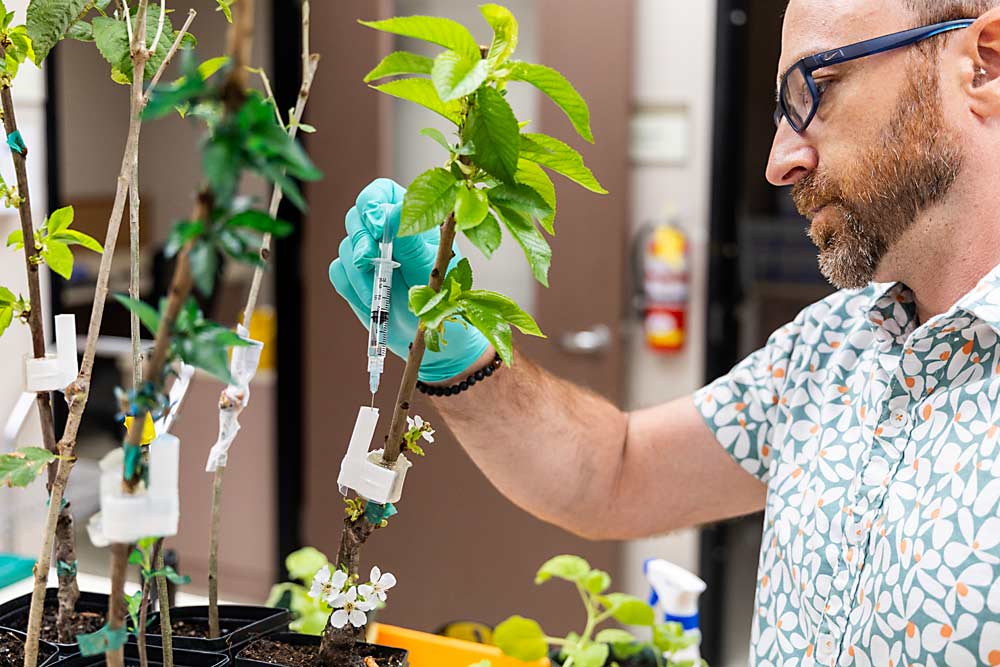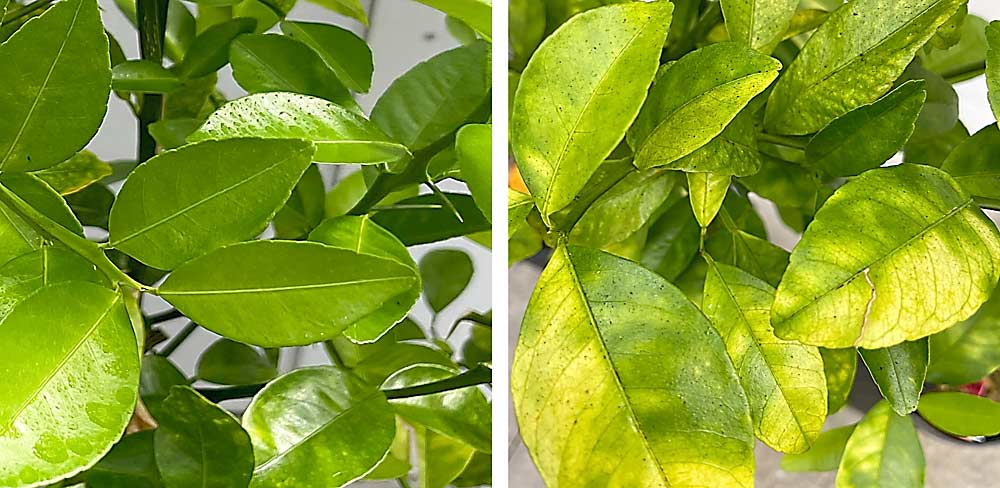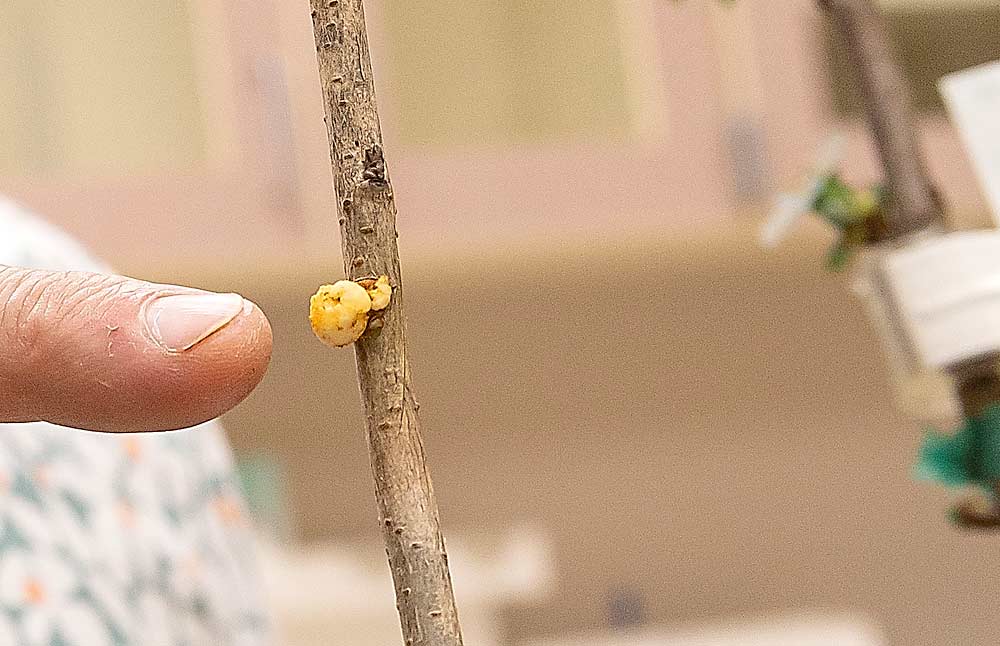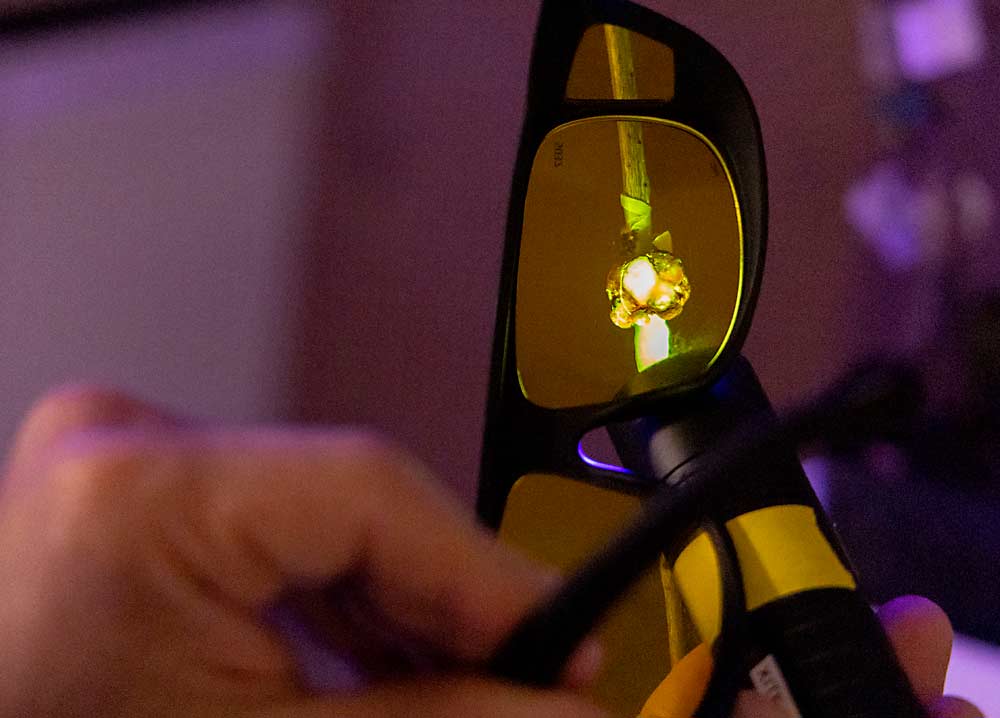—by Kate Prengaman

Imagine if you could vaccinate your cherry trees to help them fight off X disease.
A newly hired molecular biologist at the U.S. Department of Agriculture’s Wapato, Washington, lab recently launched a research program aiming to do just that — though the scientist himself doesn’t embrace my vaccine analogy because plant immune systems are so different from animals.
“It’s like a long, slow dose of antibiotics,” said Marco Pitino. Except the trees would make their own medicine after inoculation with a genetically engineered agrobacterium that sets up a little biofactory — patented and trademarked as a Symbiont — on the trunk.
“Agrobacterium is the best molecular biologist in the world, with 1 million years of experience,” Pitino said. “He introduces a gene to make food for himself, to build his house. Now, the ones we used in the lab are disarmed…. We maintain the genes that create the structure and introduce a gene of interest.”
The result functions like a self-sustaining insulin patch, producing a regular dose of molecules that keeps the tree regulated. That analogy is courtesy of Kevin Hackett, a national program leader for the USDA Agricultural Research Service.
“It’s a way of delivering different therapeutics,” he said of the technology first tested in citrus and now being studied in many crop systems. “The Symbiont system has the promise to transform agriculture and the problem of (vector-transmitted) plant diseases.”
It sounds like science fiction, but the USDA-developed Symbiont system shows promise in the citrus industry, where Pitino was part of a large research group working on the $15 million project funded by the USDA’s National Institute of Food and Agriculture: “Therapeutic Molecule Evaluation and Field Delivery Pipeline.” Under that project, scientists used new genetic technology to fight huánglóngbìng, also known as citrus greening or HLB. A field-scale trial is underway as part of a regulatory review by the USDA Animal and Plant Health Inspection Service.
Late last year, Pitino moved to Washington to begin testing the technology in cherries. The tree fruit industry, through the Northwest Horticultural Council, successfully lobbied Congress for additional funding to fight X disease, and that created Pitino’s position, said Rodney Cooper, director of the Wapato lab.
“For us to be able to take advantage of that research that’s been done over the past 10 years is huge. We’re not starting from zero like they were in citrus,” Cooper said. “He brings an entirely new expertise.”

Plants vs. pathogens
To explain his research, Pitino starts with the fundamentals of the arms race between plants and pathogens.
“Plants are constantly bombarded by fungi and bacteria, and they are not sick,” he said. What makes specific pathogens, such as the X disease phytoplasma or the HLB bacteria, into successful enemies is that they have evolved chemical warfare to suppress their hosts’ immune response.
When plant cells recognize an invader, they typically release reactive oxygen, which burns a small hole in the plant tissue to prevent the pathogen from spreading, Pitino said. Pathogens developed “effectors” that inhibit this response, turning the host into a nice home for themselves.
To illustrate just how powerful effectors are, Pitino and his colleagues in Florida tried an experiment to transfer an effector gene from the bacteria that causes HLB into a small “lab-rat” plant commonly used in lab experiments. Detection dogs trained to alert to trees infected with HLB were able to identify those plants expressing the effector gene, even though they weren’t infected with the pathogen itself, he said.
By studying the DNA of the X disease phytoplasma, which has 466 genes, Pitino hopes to identify the effectors that give it pathogenic powers. So far, he’s screening over a dozen candidates using gene editing to express them in these lab-rat plants and then observe what they do.
“If we find the effectors, we can block them,” he said. “If we stop the effectors, then the plants can respond themselves.”
That approach brings Pitino back to the potential of the Symbiont system. The goal is to harness it to produce general-acting antimicrobial proteins, as in the current citrus trials, or to produce precise compounds that block the effectors of X disease, once those are known.

Tiny trunk injections
Determining what a future Symbiont should produce to help fight X disease requires a lot of trial and error. To conduct those tests in the greenhouse, Pitino rigged up a delivery system using a 3D-printed tube and a seal made with a sticky silicon sold as fishing bait.
The method is inspired by the trunk injection approach some Florida growers use to deliver antibiotics, but it’s scaled down for tiny greenhouse trees.
When Good Fruit Grower visited in June, Pitino and lab technician Douglas Harper tested the system in cherry using blue food coloring. Twenty minutes later, the blue dye was apparent in the veins of the blossoms and young leaves, showing that it was being carried, as desired, through the phloem.
Next, they’ll need to infect some trees — with the help of an infected leafhopper colony Cooper uses to study X disease. Then, they can use the delivery system to see which antimicrobial compounds show potential for reducing symptoms and lowering disease titer.
As a delivery system, trunk injection makes sense because it puts the product where it needs to work, rather than a spray that conveys only a small amount of the active ingredient into the plant, Pitino said. The Symbiont approach would create continuous trunk injections over time after just one inoculation.

Cherry trials
This spring, several Northwest nurseries donated over 2,000 cherry trees to Pitino’s new lab.
“Now that we have plants, we can really see how the cherries do with the Symbionts,” he said.
A new grant from the Washington Tree Fruit Research Commission also supports the cherry work; the latest federal budget request for the USDA also requests additional funding to study the Symbiont technology at the Wapato lab, Cooper said.
To create a Symbiont, Pitino makes a tiny wound in the bark of the tree and inoculates it with the solution containing the engineered agrobacterium. He then covers it to protect it from light during its development.
Around the laboratory, cherry trees in pots can be seen supporting Symbionts engineered to produce green fluorescent protein that Pitino and Harper can track through the plant using black lights. The biofactory structure integrates into the plant’s vascular system, allowing molecules to flow — but with no DNA exchange. The crop plant’s DNA is not altered. This, Pitino and his colleagues hope, will help the Symbiont approach gain regulatory and eventual industry approval.
And that, proponents hope, will usher in a new era of using genetic engineering to solve agricultural problems without engineering the crops themselves. The USDA is investing in the approach in several crops, Cooper said.
“That’s the beauty of it; it opens the doors. Once the technology is accepted and through regulatory hurdles, essentially we have a tool to quickly adapt to any invasive insect or pathogen that gets dropped on us,” Cooper said. “Right now, it’s X disease, but what is Marco’s next challenge going to be?” •






Leave A Comment